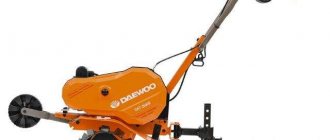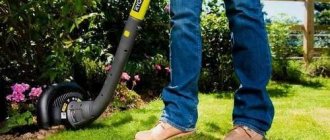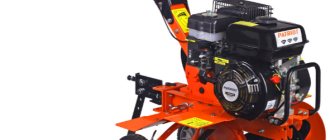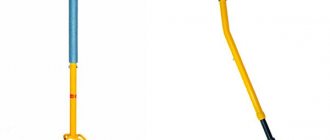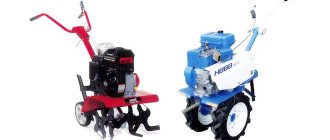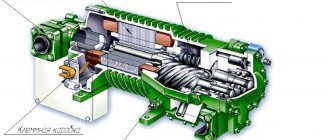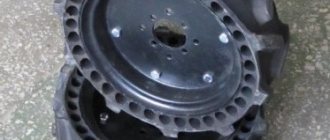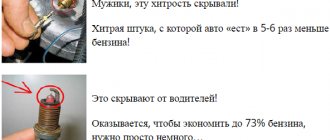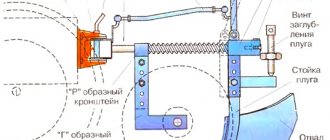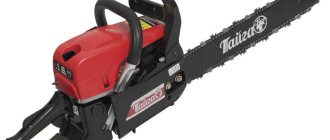The cultivator simplifies work in the garden, allows you to properly cultivate the soil, making it more fertile, in order to subsequently sow a green lawn, grow vegetables, fruit crops, and seedlings. If you are tired of painstakingly manually digging a green area, a great idea is to purchase a gasoline cultivator, which makes work in the countryside a pleasant, non-tiring task.
This modern device in small gardens can significantly facilitate soil cultivation by replacing a shovel and fork. How to choose a cultivator for your garden, what you need to know before purchasing in order to choose the model best suited for solving specific problems - our article is devoted to these issues.
What is a mini-cultivator?
The name cultivator may seem quite intriguing. It literally represents the functions that are the main task of technology - cultivating or loosening the soil, necessary when preparing the land for sowing seeds, seedlings, and applying fertilizers.
To choose a cultivator, it is important to correctly understand the goals that need to be achieved. The goals depend on the purpose of the garden:
- one model is suitable for growing fresh vegetables, fruits, berries;
- the other is useful when garden plants are intended for decoration.
The cultivator loosens the soil, due to which:
- the soil retains more nutrients and moisture;
- favorable conditions are provided for planting seedlings and seeds.
The device is especially useful in areas where:
- the soil is heavy, clayey;
- Frequent loosening and aeration are necessary so that water penetrates into the soil and does not stagnate;
- a lawn is created - cultivation will allow the grass to become evenly thick, lush, and lushly green.
Manual model for a small area
For a small garden or vegetable garden, choose a manual mini-cultivator that moves forward manually. At the front of the device there is a soil cutter driven by a motor.
Where is it used?
The width of the processed strip is in the range of 30-50 cm, which allows the device to work easier:
- in narrow beds,
- at the junction of curbs,
- near garden paths.
A manual cultivator for a summer residence will easily reach hard-to-reach places with borders, narrow flower beds, and vegetables. The manual model is only suitable for fairly soft soil.
Where does a manual model not fit?
- loosening the soil in large areas may not be very convenient - working over a larger area is too tiring for a small device;
- It is not convenient to work with such a device on hard, clay soils.
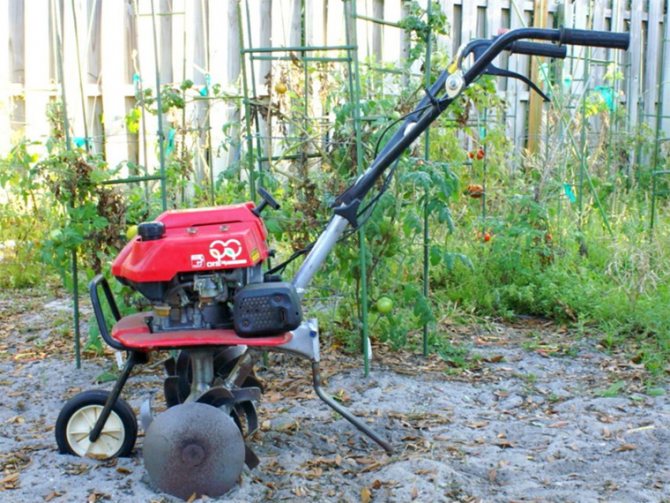
Parameters of medium power cultivators
Medium-power cultivators weigh 15-35 kilograms, and, thanks to their power level of 3-4 horsepower, are able to cope with areas from 10 to 30 acres. Most often, medium-power units run on gasoline. Their heavier weight (than lightweight ones) allows them to cultivate the soil to a greater depth. In addition, they can be used to process heavy, rain-packed soil.
However, such units also have disadvantages - they are more difficult to operate than light equipment, and are not recommended for use by pensioners and women.
Medium-power cultivators are used to cultivate summer cottages of no more than 15 acres. They combine an affordable price with excellent endurance.
Which cultivator to choose: gasoline or electric?
If you need to cultivate a garden plot, you can buy a gasoline or electric garden cultivator; each type has advantages and disadvantages. Before choosing a suitable cultivator, let’s analyze their advantages and disadvantages.
- The electric model is useful on almost any type of soil, in medium-sized plots. On hard ground, you should choose models with teeth made of hard materials. The disadvantage of the electrical device is the cable; during operation you have to use extension cords.
- Gasoline model . The gasoline cultivator runs on fuel and is not limited by cable length. Ideal for working on large areas.
Parameters of light cultivators
Most light cultivators are electric. Since their body does not contain a heavy motor, such units have high maneuverability. They are easy to manage. And the fact that mainly women have to do earthworks, these devices are just suitable for being controlled by gentle, weak hands. A lightweight cultivator weighs no more than 15 kg, but there are also miniature models weighing up to 9 kg. They can be easily carried to any part of the garden or vegetable garden, even by women, because they weigh no more than a ten-liter bucket of water.
Operating a lightweight cultivator is not difficult, and any woman can handle it. The problem with electric cultivators is that their wires get tangled underfoot. It is necessary to constantly ensure that the wire is not cut by the cutter or that it does not jump out of the socket.
It is impossible to cultivate the soil to great depths with light equipment. The maximum cultivation depth with this device is 20 cm. This cultivator can be used to cultivate small areas (maximum 10 acres) where the soil is loose and well-cultivated. A lightweight cultivator cannot cope with heavy soils.
But in the limited spaces of greenhouses, such units will be of great help to the summer resident. The only inconvenience of electric models of light cultivators is the presence of a cord, which limits the work area and gets tangled underfoot.
Mini cultivator
Thanks to the mini device, we save a lot of time and energy on cultivating large areas of land, even without using electricity. The price of a gasoline mini cultivator starts at 8,500 rubles, but the owner of the device will quickly appreciate the useful functions. Equipment driven by a gasoline engine copes well with processing even hard soil.
When choosing a model, you should pay attention to a useful function - reverse gear. Thanks to it, work will become easier, more enjoyable, and much faster than in more modest, inexpensive models.
Owners of a large plot of land will benefit from garden cultivators that resemble tractors, mini tractors, which can be converted into:
- harrows,
- plows,
- cultivators.
This option will cost much more, but the versatility of the device will allow you to save money.
Classification of manual soil cultivators
There are various designs of rippers that have their own mechanisms for crushing compacted soil and eliminating entrenched weeds.
Traditional types of cultivation tools include forks and rakes, which have been used for a long time to break up clods and form beds. Their wooden counterparts are well suited for loose and softened soil.
There are also special types of devices that are small in size and can be used both in beds and in small flower beds, near fences and in spaces between bushes. These include:
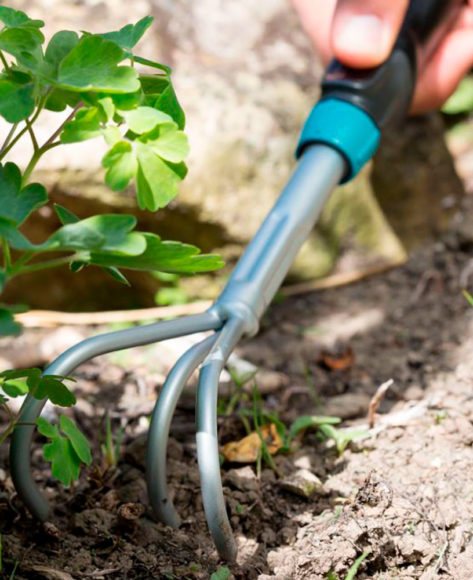
Star devices. The tip in the form of toothed discs does an excellent job of loosening the soil. Such models can be supplemented with a knife designed to simultaneously pull out weeds.- Rippers-cultivators. A good option for hard soil. Curved teeth effectively crush compacted areas.
- Flat cutters are a suitable tool for processing the surface layer of the earth using sharp flat knives and removing weeds.
Universal designs that combine several functions are also popular:
- Fokina ripper. A device that allows you to perform over 20 types of garden work. Its main purpose is to extract weeds, with a root depth of up to 2 cm. This treatment is safe for plants and beneficial insects inhabiting the earth. The device looks like curved brackets.
- Tornado is a device with long teeth curved counterclockwise, which, when you turn the handle, uproots even the most stubborn weeds.
- The mole is a productive device for digging and cultivating. Includes a pair of forks that work like scissors and a metal frame. The device allows you to cover a large area and penetrate deep into the ground.
We invite you to familiarize yourself with the Dominant chicken breed with a list of colors
Additional accessories
Modern small cultivators can solve problems with loosening the soil, and also perform:
- aeration;
- dig up;
- soil leveling;
- shovel snow.
It is advisable to choose a device for which you can purchase additional accessories:
- plow;
- harrow;
- cultivator;
- rake;
- snow plow;
- digger for potatoes and other vegetables.
Accessories eliminate the need to buy multiple devices, save money and space for storing tools.
Device settings
When choosing, you should consider the most important parameters of the device:
- The ability to adjust the rotation speed of the mechanisms affects the structure of the treated soil - the higher the speed, the more fragmented the soil.
- Working width of the cultivator design. It is important to choose this parameter according to the area of the site:
- for a small garden area, a width of up to 40 centimeters is sufficient;
- for large areas it is more profitable to choose cultivators with a width of 50 cm;
- Among the wide variety of walk-behind tractors, you can also choose models with universal dimensions of 45 cm, for working on small and large areas;
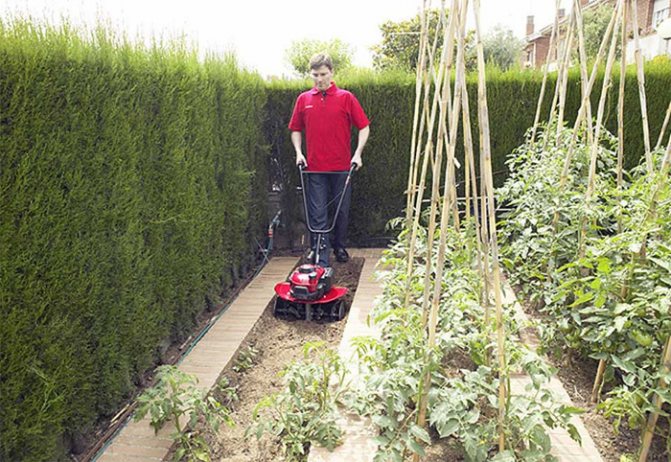
- Engine power is an important parameter. More powerful models cope with tough weedy areas and will allow you to loosen the soil in neglected areas. Power is selected depending on operating conditions:
- It is recommended to use models with a power of 0.6 kW or more for large areas, clayey, loamy, rough soil, where high power equipment is especially important;
- For small gardens, a motor power of 0.2-0.5 kW is sufficient.
- Mobile capabilities – ease of maneuvering of the device is very important in the garden. It is worth considering models that have reverse gearing - this will help maneuver, which is important when working in large areas of the garden, in the case of a large number of trees and shrubs.
- Individual settings of the rototiller will allow you to adjust the rotation of the blades and the working depth.
Peculiarities
An electric walk-behind tractor is a small agricultural machine with an electric motor powered by a network or battery. The electric motor transmits force through the gearbox to the working unit of the cultivator, which is in direct contact with the soil. You can regulate the degree of impact on the soil, its loosening or plowing using the handles. In addition, the unit has a special depth regulator with adjusting bolts. For ease of control, the machine is equipped with one or a pair of wheels (depending on the model).
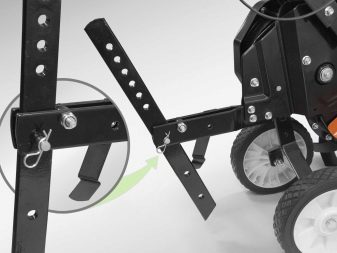
Of course, for owners of farmland that require work on an industrial scale, an electric walk-behind tractor will seem like a useless toy. But this unit is perfect for tidying up the garden at the dacha. In a small area it is easy to provide constant power from the electrical network or recharge the battery. As for the functionality and performance of such a unit, on private territory it is able to quickly and efficiently complete the required amount of work. A walk-behind tractor with a set of attachments and tools is capable of solving a very wide range of tasks.
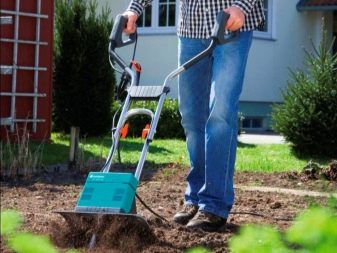
Electric options are absolutely harmless from an environmental point of view. Another plus is that such machines are almost silent. The absence of vibration and easy controllability allow the unit to be used by elderly people and women. Compared to gasoline or diesel engines, electric devices are more economical. At the same time, battery models are not inferior to gasoline and diesel cars in terms of maneuverability.

As for the disadvantages, the small dimensions of electric walk-behind tractors affect a slightly smaller range of attachments. However, this nuance is offset by numerous advantages, which encourages buyers to choose electrical equipment.
Based on capabilities and sizes, electric walk-behind tractors can be divided into three groups.
- Light walk-behind tractors (cultivators) have the most modest dimensions. The purpose of such machines is to work indoors in greenhouses and greenhouses. They are also used to loosen the soil in flower beds. Weighing no more than 15 kg, such a self-propelled vehicle is easy to operate and accessible for use by women.
- The middle weight category consists of electric walk-behind tractors weighing up to 35 kg. Such machines can be useful on a standard-sized summer cottage. Among them there are models capable of plowing a garden of 30 acres. All you need is a large extension cord.
- Heavy electric walk-behind tractors are capable of working on plots of 50 acres or more. These are quite heavy machines weighing up to 60 kg. With their help you can even process virgin soil.
Precautionary measures
Modern country cultivators have a number of certificates that allow them to be sold and used safely. It is important to take precautions:
- Any fuel leaks should be checked for any fuel leaks before use.
- Small cracks can cause serious damage.
- For any question, it is advisable to consult with the dealer or manufacturer.
- We must not forget about the correct choice of clothing, which guarantees speed and safety of work.
- Particular care should be taken in high humidity, risk of precipitation, or on uneven ground.
Rating
Below are some reliable and popular models.
1. The Hecht 785 gasoline cultivator meets the expectations of every gardener. Specifications:
- working width – 84 cm;
- engine type: internal combustion;
- engine capacity 195 cm³;
- engine power 6.5 hp;
- weight – 52 kg;
- equipped with a set of steel blades with a diameter of 38 cm, giving the ability to control the working width in the range of 32/50/84 cm, which is invaluable in different environments with different soil qualities;
- stainless steel steering wheel;
- there is a safety lever that prevents accidental operation of the knife;
- the model is made of stainless steel, which ensures a long service life;
- has 2 speeds: forward and reverse;
- It is possible to purchase additional accessories: lister, single-sided plow, potato digger, 2 types of wheels.

2. Texas tx601tg walk-behind tractor. Specifications:
- engine: Texas Powerline TG720 212 cm³, 5.7 hp;
- working width: 36-55-85, depth: 33 cm;
- gears: 1 forward, 1 reverse;
- blade rotation speed: 110 rpm.
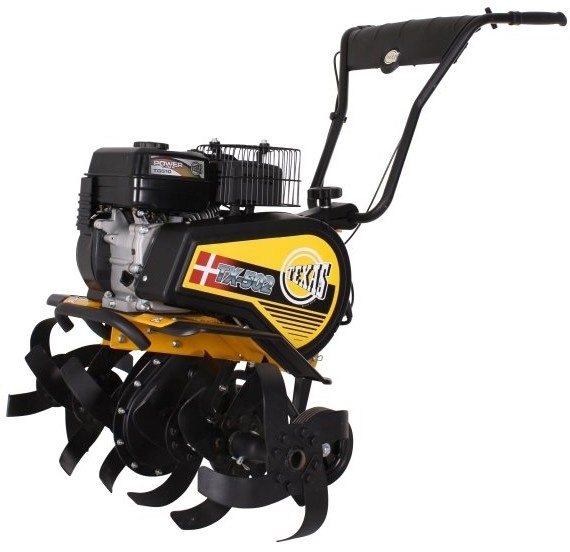
3. Walk-behind tractor WMX650 7KM is a powerful device. Specifications:
- engine – single-cylinder, four-stroke, air-cooled, reduction 2:1;
- engine capacity – 208 cm³, power 7 hp. (5.15 kW) / 1800 rpm;
- fuel – unleaded gasoline;
- tank volume – 3.7 l;
- noise level – 97 dB;
- wheel drive gears – chain;
- oil sensor;
- working depth – 150-300 mm;
- width – 300-600 mm;
- 2 independent axes, 2 knife axis speeds;
- 2 forward gears + 2 reverse gears;
- the steering wheel rotates 180 degrees;
- height-adjustable steering wheel, start/stop button on the steering wheel;
- engine speed control on the steering wheel;
- The kit includes rubber wheels, metal discs, 2 sets of knives, 2 sets of arches;
- weight – 97 kg.
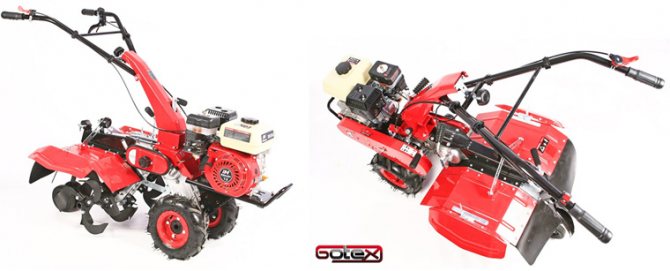
4. The Honda FG 320 rotary cutter replaces the proven, previously popular FG 314 and FG +315 rotary cutters, ideal for large gardens, growing vegetables, and laying a lawn. Specifications:
- width – 80 cm,
- 6 knives, 2 discs;
- engine capacity 135 cm³;
- maximum power – 4.6 hp;
- Tank capacity – 2 liters;
- average working time – 1.3 hours;
- blade diameter 32;
- blade operating speed rpm – 116;
- dimensions (length x width x height) – 60 x 111 x 140 cm;
- weight – 52 kg.
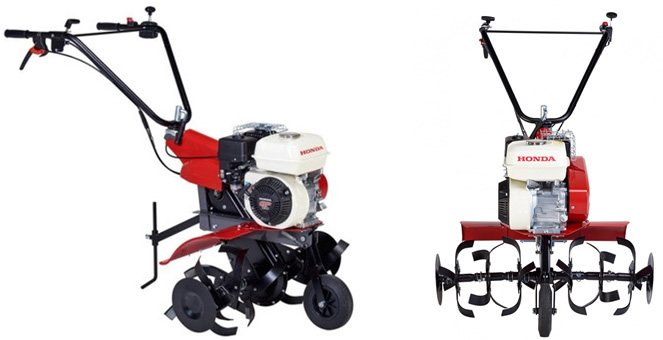
5. The HECHT 747 motor cultivator will easily loosen the soil. Technical specifications:
- internal combustion engine BRIGGS & STRATTON 500 E with a power of 2.9 hp, a volume of 140 cm³,
- 4-6 blades with a diameter of 26 cm;
- weight 36 kg;
- working width of the device is 36-60 cm depending on the number of inclined blades;
- color – red-black;
- the ability to expand/narrow the width of the block depending on needs;
- steel structure, steel blades;
- number of gears – 1;
- fuel tank capacity – 1.6 l;
- engine – 4-stroke.
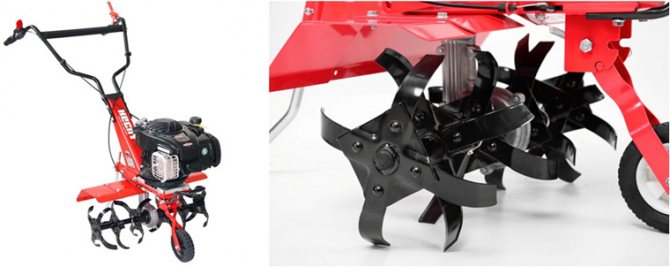
6. Hecht 761 motor cultivator . Technical parameters:
- four-stroke internal combustion engine with a volume of 139 cm³, 5 hp,
- 4 blades with a diameter of 26 cm,
- 1 toothed cutter with a working width of 36 cm,
- weight 34 kg.
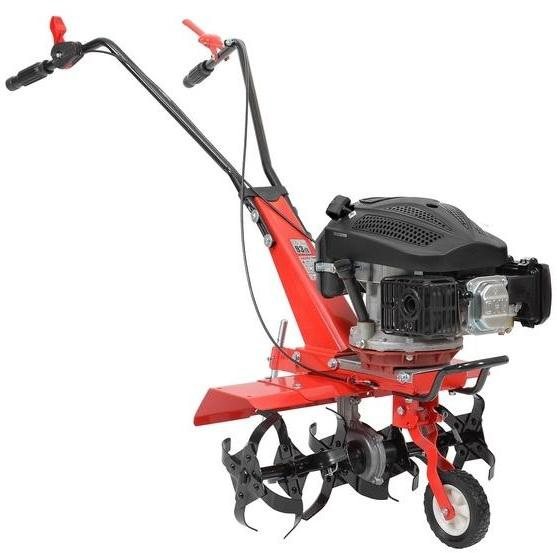
7. Gasoline multicultivator FUXTEC 6.5 + plow – a universal model designed for the garden. Specifications:
- LONCIN G200F engine – excellent quality, reliability, ease of use, oil air filter provides the most thorough filtration in dusty working environments;
- large wheels provide easy maneuvering;
- 6 knives work at a width of 50 cm;
- additional accessories do not require consoles - plow, lister, potato digger, hoe, additional wheels, aerator, rake;
- engine capacity 196 cm³;
- power 6.5 hp;
- maximum engine speed 3600 rpm;
- fuel tank capacity 3.6 l;
- width – 500 mm, depth – 175-350 mm;
- noise level – 81 dB;
- weight – 69 kg.
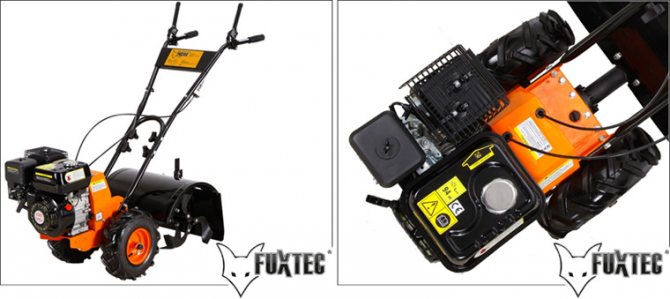
Motor cultivator – cultivator with a gasoline engine
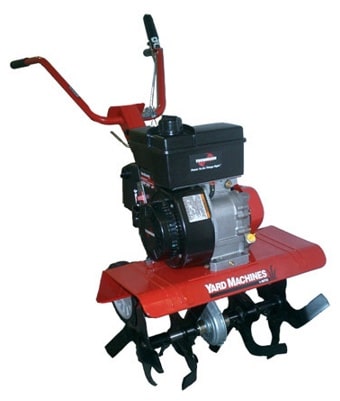
Its engine runs by burning fuel - it does not require a “tether” in the form of a cord and an electrical outlet. Therefore, a gas cultivator is a fairly independent device capable of cultivating the most remote areas. When choosing a motor cultivator, you should understand that the engine of this device can be two-stroke or four-stroke. A two-stroke engine runs on a mixture of gasoline and oil, while a four-stroke engine uses only gasoline. The latter type is more advanced, as it produces less noise and vibration during operation, and is also more economical in fuel consumption.
Depending on their weight and technical capabilities, gasoline cultivators are divided into:
- Ultralight – weight up to 15 kg
- Lightweight – weight up to 40 kg
- Medium – weight 45 – 60 kg
- Heavy – weight more than 60 kg
Ultra-light motor cultivators
Ultra-light models with engines up to 1.5 - 3 liters. With. (horsepower) are intended for processing flower beds, flower beds, small vegetable gardens, etc. The grip of such cultivators is only 20 - 30 cm, which makes them as compact and convenient as possible. Since they plow the ground to a depth of no more than 8 cm, accordingly, there is no point in using them in uncultivated, abandoned areas with a lot of weeds.
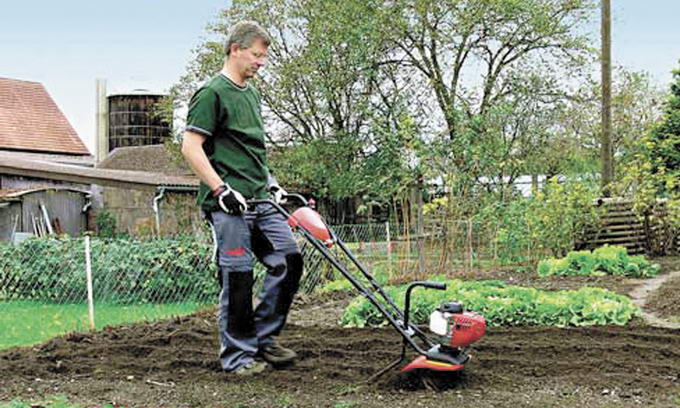
Ultralight cultivators are so small that they can be easily carried in a backpack or transported in the trunk of a car. For ease of transportation they are equipped with removable handles.
Light motor cultivators
Light motor cultivators are equipped with engines with a power of 2.5 - 4.5 liters. With. Their grip is larger than that of ultra-light models and is 40 - 50 cm. Accordingly, their productivity is 1.5 - 2 times higher. In addition, they are capable of loosening the soil to a depth of 15 - 18 cm. A light cultivator usually includes a small hiller, which is designed for cutting planting furrows for various crops.
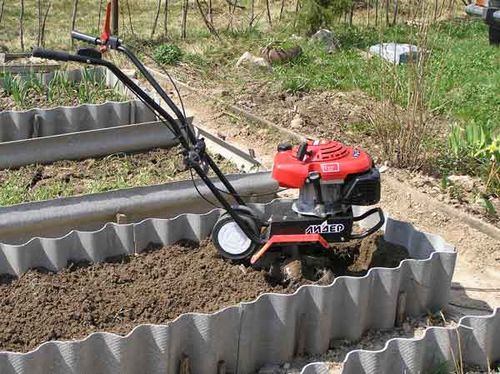
Lightweight motor cultivators are distinguished by good maneuverability, ease of transportation and quite sufficient performance. However, they have a drawback: they cannot be used for a long time, so they are used mainly for cultivating soft soils in flower beds, greenhouses, and greenhouses. This technique will not cope with virgin lands, but can be used as a means for additional cultivation after plowing the area with a tractor.
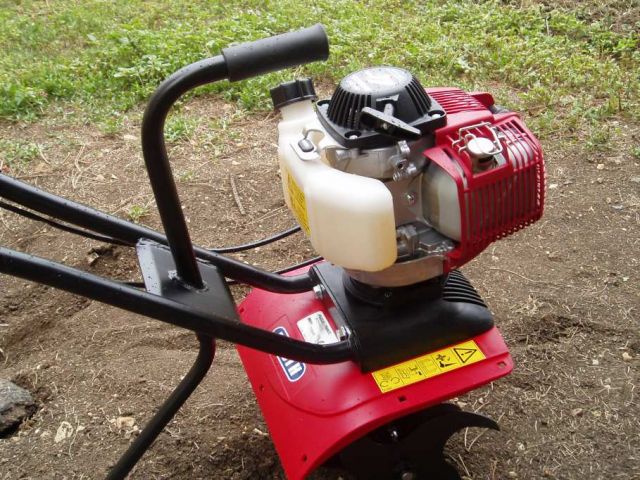
Most often, light cultivators are equipped with a plastic worm gear, which is not particularly reliable. Manufacturers of such products recommend checking the lubricant level in the transmission every 60 hours of operation of the unit to prevent breakdowns and replenish its losses as necessary. This will extend the life of the gearbox and eliminate the breakdown of expensive machine parts.
When choosing light equipment, pay attention to the presence of reverse gear. The fact is that the presence of a worm gear does not allow the car to be rolled back when colliding with an obstacle, which is very inconvenient.
Medium cultivators
Medium cultivators are equipped with engines with a power of 4 to 6 liters. With. Due to their fairly large weight, they are more stable than lightweight models, which often “bounce” on dense soils. The wide grip of the cutters of medium-sized motor cultivators (40 - 85 cm) allows you to cultivate a large area of land to a depth of 25 - 28 cm in one pass.
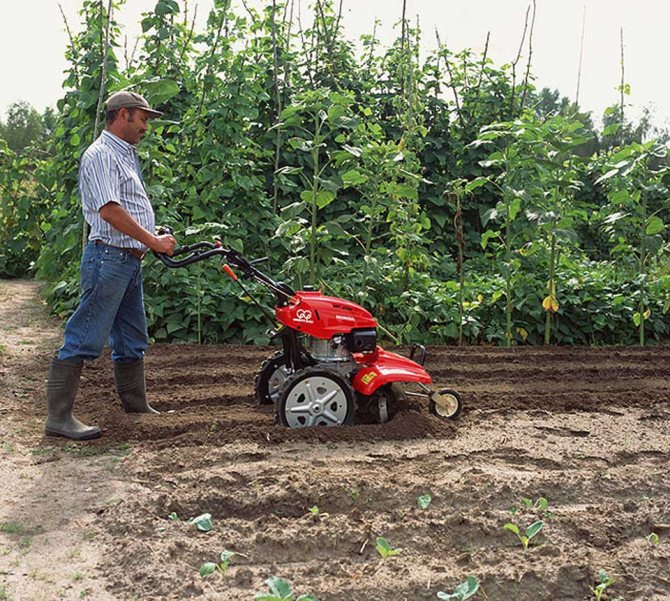
Middle class cultivators, unlike light models, are able to cope not only with soft greenhouse soils, but also with clay soils. However, they are still not suitable for the development of virgin lands, due to the simplified mechanical part and the possibility of breakdown, the risk of which arises when transferring revolutions from a gasoline engine to cutters located in front. The cutters in light and medium cultivators not only loosen the ground, but also move the machine forward, so in the event of a possible collision with an obstacle, considerable effort must be made to pull the cultivator out of the ground. Sometimes it is necessary to turn off the drive and pull the machine back 1 - 2 m.
Some middle-class models already have a chain gearbox, which compares favorably with a worm gearbox in terms of service life, efficiency, the ability to roll the machine away when buried in the ground and the use of attachments.
Medium-sized motor cultivators can be equipped not only with a hiller, but also with a small plow, harrow, and mower.
Heavy cultivators
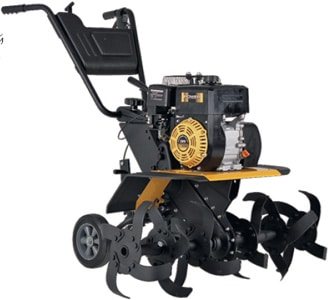
With. and can be used not only for hilling a summer cottage, but also for large agricultural plots with an area of more than 10 acres. This is the type of unit that should be preferred for the cultivation of virgin lands. For comfortable work with heavy equipment, you should apply pressure during its operation in a ratio of 1 kg per 1 cm. If this is not done, the cultivator will jump around the area or “burrow” into the ground. The pressing of the equipment is carried out due to its weight supported by the opener. You need to press the handle down - the cultivator will go deeper into the ground, lift it up - the device will also rise. Despite the fact that these are quite heavy motor cultivators, consumer reviews indicate their significant convenience, especially since they are often equipped with wheels and the unit drags itself (the cutters of such equipment are located at the rear).

A heavy motor cultivator can be supplemented with any tool: a plow, a potato planter, a mower, a harrow, a cargo cart. Equipment of this class has the least vibration and is designed for maximum long-term operation. However, despite the many functions, buying a heavy motor cultivator is not always justified. This unit is not suitable for small farms, because it will not be able to pass along narrow paths and passages between beds or in a greenhouse.
